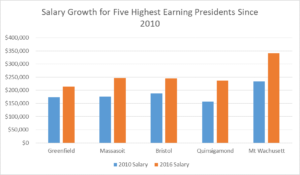Community College Presidential Pay Raises Not Necessarily Based on Merit
Last year saw some of the highest recorded salaries for presidents of Massachusetts community colleges. The presidents of Greenfield, Bristol, Massasoit, Quinsigamond, and Mt Wachusett Community Colleges receive the highest, with annual earnings in the mid-$200,000 range. These salaries are the result of rapid growth in the last five-to-six years.
Compensation is generally based on more than performance; experience and institutional characteristics factor in to determine a president’s salary. Salaries also tend to increase over time due to factors like inflation and a changing economy. However, some presidents have seen dramatic pay raises that far outpace the expected norm.
For the six-year period (2016 is the last year for which data are available), Greenfield Community president Robert Pura saw his $173K salary increase by 23% to $213K; Bristol Community president John Sbrega received a 30% raise from $188K to $245K, and Massasoit Community president Charles Wall enjoyed a 40% jump from $176K up to $246K. Quinsigamond president Gail Carberry received a conspicuous 50% salary increase, bringing her 2010 paycheck of $157K up to $236K. (To note, even a 5% annual pay increase compounded over six years results in a near 30% salary bump.)
This trend begs the question: Do student outcomes justify these raises? The answer appears to be a mixed bag.
We looked at each of these schools’ enrollment rates, full- and part-time retention rates, graduation rates, and transfer-out rates. Retention rates measure the percentage of students that return to a college every academic year, essentially quantifying students’ overall satisfaction with the quality of education they’re receiving. A high transfer-out rate, similar to a high graduation rate, is a marker of a community college’s effectiveness at preparing its students for success at a four-year institution. A college’s reported graduation rate pertains only to students graduating from that specific school.
Pura has led Greenfield for 17 years. Since 2010, the school’s enrollment has dropped by 12%. However, its graduation rate also shot up by a third in that six-year window, part-time retention increased by 12%, and the school has maintained a comparatively high 24% transfer rate.
Wall, having been at Massasoit since 2002, is another long-time educational administrator and president. With a $246K base salary, he is the state’s second highest paid community college president and substantially outearns most of his peers. Indeed, Massasoit largely seems to outperform its counterparts: By 2016 the school boosted its graduation rate by a third and its enrollment by 5% since 2010, while maintaining both full- and part-time retention. Its transfer-out rate has dipped slightly, down to 22% in 2016 from 25% in 2010, but it’s still one of the highest among the commonwealth’s 15 community colleges.
Bristol President John Sbrega earns $245K. Sbrgea began his tenure in 2000, and under his direction the school has made considerable progress by almost every measure. It raised its graduation rate by half, bumped up its transfer-out rate by 18%, and increased enrollment by 5%. Full- and part-time retention rates dropped by 8% and 4%, respectively.
At $236K, Quinsigamond president Gail Carberry not only earns a comparatively high salary, but has received the largest raise since 2010. Quinsigamond’s enrollment has increased by 15%, its part time retention rate has jumped nearly a quarter, and its graduation rate has seen a one percentage-point increase since 2010. However, its transfer rate has dived from 20% in 2010 to 13% in 2016.
Other presidents are receiving lucrative retirement packages and payouts. When Mt Wachusett Community President Daniel Asquino retired this past fiscal year, he took with him a $68,078 “buyout” on top of his $274K base salary. The buyout consisted of unused vacation and sick days he had accumulated. According to the Worcester Telegram, his retirement package was extra generous because of his “lengthy service,” the longest of any university president (he’d been at the college for 29 years). The Telegram also reported that Asquino’s annual pension could be as much as $215,000.
Given the extent to which Mt Wachusett is rewarding its departing leader, it would be natural to assume that the college boasts excellent success rates. Indeed, its students are by no means underperforming; the school’s 2016 graduation rate was 20%, very respectable relative to its peers. However, Mt Wachusett has also seen its enrollment drop by 8% and its transfer-out rate drop by 18% since 2010.
Bunker Hill president Pammy Eddinger is also on the high end of the presidential pay scale, with a salary of $215K. While Bunker Hill has substantially increased its enrollment – up 37% from its 2010 number – and maintained its 2010 transfer-out rate of 23%, the school’s graduation rate continues to be abysmal. Seven years ago, it was an unimpressive 13%. It has since sunk even lower, to 9% in 2016. This is far below the national average: The Community College Research Center puts the average graduation rate for first-time students seeking a degree from a two- or four-year institution at 39% in six years. This below-par performance is not specific to Bunker Hill; Massachusetts community colleges as a whole under-perform compared to their counterparts across the country.
Meanwhile, some schools demonstrate that presidential salaries and high student performance are by no means linked. Middlesex Community and Cape Cod Community presidents James Mabry and John Cox made modest incomes relative to their peers in 2016, at $197.5K and $199K, respectively. Their students, however, are thriving. Since 2010, Middlesex’s graduation rate has increased by nearly a quarter, its transfer-out rate stayed at 26% (the highest of all 15 community colleges), and both its enrollment and full- and part-time retention rates have remained stable.
Since 2010, Cape Cod Community more than doubled its graduation rate, from 9% to 20%, maintained a 22% transfer-out rate, and substantially increased retention rates across the board. Its enrollment did see a dip, down 18% from its 2010 number.
Indeed, Massachusetts appears to be more generous with presidential compensation than its peers nationally. A 2016 American Association of Community Colleges report detailed average community college president salaries and found that compensation varied depending on factors like region and enrollment. The average enrollment for a Massachusetts community college is 8,709 students. According to the report, the average base salary for the president of a school in this enrollment bracket is approximately $195K nationwide, with average total cash compensation at $200K. In 2016, the average base salary for a Massachusetts community college president was $206K, with total compensation averaging $210K. (Asquino’s 2016 buyout brought up the commonwealth’s average.)
Of course, community college presidents earn far less than their private sector counterparts (the presidents of Northeastern and BU earned $1 million and $1.2 million, respectively, in 2015). But it’s important to maintain perspective: $245,000 is a considerable amount of money – taxpayer money. The presidents’ retirement packages are also based on a percentage of their pay that the commonwealth is on the hook to cover for years to come.
These presidents are entrusted with safeguarding and advancing the education of thousands of students every year, many of whom are low income and night students. Before raises are handed out, it would perhaps behoove college administrations to set defined measures of student outcomes and to consider linking pay to achievement. Even better, make the measures transparent so that taxpayers can properly understand what they’re paying for.
Charlotte is a newly minted graduate of Boston University, where she majored in political science. She is a Roger Perry Government Transparency Intern for summer 2017, focusing on education.




